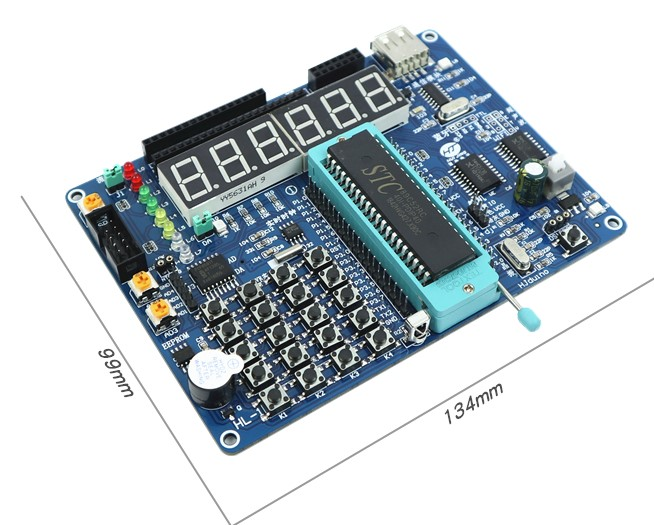信号发生器的设计(期末课程设计)
题目:信号发生器的设计
设计一个信号源,可以输出三种波形(正弦波,方波,三角波),通过按键可以改变输出波形,也可以改变波形的频率,并且频率可以通过数码管显示出来(频率显示到个位,大概正确就好,不用太准确)。
1、实现正弦波的输出,并且能够改变频率,5分。
(1)实现正弦波的输出,2分
(2)能够改变频率,1分
(3)能够显示频率,2分
2、实现方波的输出,并且能够改变频率,5分。
(1)实现方波的输出,2分
(2)能够改变频率,1分
(3)能够显示频率,2分
3、实现三角波的输出,并且能够改变频率,5分。
(1)实现三角波的输出,2分
(2)能够改变频率,1分
(3)能够显示频率,2分
提问环节:教师提问有关信号源的3个问题,根据学生回答情况给分,每个问题5分,满分15分。
使用的单片机:

注意事项:
1.频率只显示到个位,所以在周期 t上做了一些限制(见代码注释)。
2.按按钮时,按下要停一段时间(等待一个周期走完),按钮才会起作用。
参考代码:
说明:次程序用单片机上的LED灯来模拟波的输出。
K1:切换输出波
K2:频率降低
K3:频率提高
默认频率:方波f1=5, 三角波f2=1, sin正弦波f3=1
代码注释写的比较细,便于大家理解,但是老师会考的很简单,不会针对某一语句问你问题的。比如会问你dispFre()那一块的代码是实现什么功能的, 频率计算公式为什么这样写等等。
1 //hill20200709 2 #include<reg52.h> //头文件 3 #include<intrins.h> //左右移函数头文件 4 #define uchar unsigned char //宏定义变量,相当于起个别名 5 #define uint unsigned int 6 7 //按键声明 8 sbit K1=P3^4; 9 sbit K2=P3^5; 10 sbit K3=P3^6; 11 12 //3种波的周期t 13 int t1=100; //单位为ms 14 int t2=2; 15 int t3=2; 16 17 //数码管显示时需要的数组,数组元素对应显示的状态 18 uchar code table[]={ 19 0x3f,0x06,0x5b,0x4f, 20 0x66,0x6d,0x7d,0x07, 21 0x7f,0x6f,0x77,0x7c, 22 0x39,0x5e,0x79,0x71}; 23 24 //数码管显示时需要的位声明 25 sbit DU =P2^6; 26 sbit WE =P2^7; 27 28 //形成sin的波形用到的数组 29 uchar code tosin[256]= 30 {0x80,0x83,0x86,0x89,0x8d,0x90,0x93,0x96,0x99,0x9c,0x9f,0xa2,0xa5,0xa8,0xab,0xae,0xb1,0xb4,0xb7,0xba,0xbc,0xbf,0xc2,0xc5 , 31 0xc7,0xca,0xcc,0xcf,0xd1,0xd4,0xd6,0xd8,0xda,0xdd,0xdf,0xe1,0xe3,0xe5,0xe7,0xe9,0xea,0xec,0xee,0xef,0xf1,0xf2,0xf4,0xf5 , 32 0xf6,0xf7,0xf8,0xf9,0xfa,0xfb,0xfc,0xfd,0xfd,0xfe,0xff,0xff,0xff,0xff,0xff,0xff,0xff,0xff,0xff,0xff,0xff,0xff,0xfe,0xfd , 33 0xfd,0xfc,0xfb,0xfa,0xf9,0xf8,0xf7,0xf6,0xf5,0xf4,0xf2,0xf1,0xef,0xee,0xec,0xea,0xe9,0xe7,0xe5,0xe3,0xe1,0xde,0xdd,0xda , 34 0xd8,0xd6,0xd4,0xd1,0xcf,0xcc,0xca,0xc7,0xc5,0xc2,0xbf,0xbc,0xba,0xb7,0xb4,0xb1,0xae,0xab,0xa8,0xa5,0xa2,0x9f,0x9c,0x99 , 35 0x96,0x93,0x90,0x8d,0x89,0x86,0x83,0x80,0x80,0x7c,0x79,0x76,0x72,0x6f,0x6c,0x69,0x66,0x63,0x60,0x5d,0x5a,0x57,0x55,0x51 , 36 0x4e,0x4c,0x48,0x45,0x43,0x40,0x3d,0x3a,0x38,0x35,0x33,0x30,0x2e,0x2b,0x29,0x27,0x25,0x22,0x20,0x1e,0x1c,0x1a,0x18,0x16 , 37 0x15,0x13,0x11,0x10,0x0e,0x0d,0x0b,0x0a,0x09,0x08,0x07,0x06,0x05,0x04,0x03,0x02,0x02,0x01,0x00,0x00,0x00,0x00,0x00,0x00 , 38 0x00,0x00,0x00,0x00,0x00,0x00,0x01,0x02 ,0x02,0x03,0x04,0x05,0x06,0x07,0x08,0x09,0x0a,0x0b,0x0d,0x0e,0x10,0x11,0x13,0x15 , 39 0x16,0x18,0x1a,0x1c,0x1e,0x20,0x22,0x25,0x27,0x29,0x2b,0x2e,0x30,0x33,0x35,0x38,0x3a,0x3d,0x40,0x43,0x45,0x48,0x4c,0x4e , 40 0x51,0x55,0x57,0x5a,0x5d,0x60,0x63,0x66 ,0x69,0x6c,0x6f,0x72,0x76,0x79,0x7c,0x80 }; 41 42 char n; 43 44 //延时函数 45 void delayms(uint ms) 46 { 47 uint k,l; 48 for(k=ms;k;k--) 49 for(l=110;l;l--); //约1ms 50 } 51 52 //显示频率函数 (很重要) 53 void dispFre(uint flag){ //参数flag判断是哪种波形 54 55 int f,num; 56 57 if(flag==0){ //flag=0判断是方波 58 f=1000/((2*t1)); //频率计算公式(自动类型转化为整型) 59 } 60 else if(flag==1){//flag=1判断是三角波 61 f=1000/(400*t2); //频率计算公式 62 } 63 else{//flag=2(其他) 判断是正弦波 64 f=1000/(256*t3); //频率计算公式 65 } 66 67 num=f%10; //只要个位 68 69 DU=1; 70 P0=table[num]; 71 DU=0; 72 WE=1; 73 P0=0xdf; //1101 1111 只要第6个数码管亮 74 WE=0; 75 delayms(2);//延时函数 76 } 77 78 79 void square() //方波 80 { 81 P1=0; //LED全灭 82 delayms(t1);//延时函数 83 84 P1=255; //LED全亮 85 delayms(t1);//延时函数 86 } 87 88 void triangle() //三角波 89 { 90 int a,x,y; 91 for(x=200;x;x--) 92 { 93 a++; 94 delayms(t2); //200个循环,每个循环a加一 95 P1=a; 96 } 97 for(y=200;y;y--) 98 { 99 a--; 100 delayms(t2); //200个循环,每个循环a减一 101 P1=a; 102 } 103 } 104 105 void sin() //正弦波 106 { 107 int i; 108 for(i=0;i<=255;i++) 109 { 110 P1=tosin[i]; //调用数组,形成sin的波形 111 delayms(t3); 112 } 113 } 114 115 void key_switch() //定义切换波形的按键函数 116 { 117 if(K1==0) //定义负责K1的函数 118 { 119 delayms(10); //防抖,下面同理 120 if(K1==0){ 121 n++; 122 if(n==3){ 123 n=0; 124 } 125 while(!K1); //K1按下去了就一直运行空循环 126 } 127 } 128 } 129 void key_plus(){ //定义负责K2的函数实现周期t加,f减 130 if(K2==0){ 131 delayms(10); 132 if(t1<520){ //t1=500时,f=1; 等于520时f=0 133 t1=t1+20; 134 } 135 else{ //f减到0时,自动复位到初始的5 136 t1=100; 137 } 138 if(t2<3){ //t2加到3时 f=0 139 t2++; 140 } 141 else{ 142 t2=2; 143 } 144 if(t3<4){ //t3加到4时 f=0 145 t3++; 146 } 147 else{ 148 t3=2; 149 } 150 while(!K2); 151 } 152 } 153 void key_minus(){ //定义负责K3的函数实现周期t减,f加 154 if(K3==0){ //时间出现负数的时候程序会卡死,且数码管就1位,所以要对t限制 155 delayms(10); 156 if(t1>60){ //t1=60时,f=8; 等于40时f=12 157 t1=t1-20; 158 } 159 else{ //f加到8时,自动复位到5 160 t1=100; 161 } 162 if(t2>0){ //t2 163 t2--; 164 } 165 else{ 166 t2=2; 167 } 168 if(t3>0){ //t3 169 t3--; 170 } 171 else{ 172 t3=2; 173 } 174 while(!K3); 175 } 176 177 } 178 179 void main() 180 { 181 182 while(1) 183 { 184 key_switch();//实现切换波形的函数 185 key_plus(); //实现周期增加、频率减小的函数 186 key_minus(); //实现周期减小、频率增加的函数 187 dispFre(n); //显示频率到数码管 188 189 //下面的代码(非常重要)实现判断需要输出那种波形 190 if(n==0){ 191 square(); //方波 192 } 193 else if(n==1){ 194 triangle(); //三角波 195 196 } 197 else{ 198 sin(); //正弦波 199 200 } 201 202 203 } 204 }
三种波及频率计算(原理结合代码)

本人单片机初学者,多多关照!文章内容肯定有不当之处,敬请指出改正。



